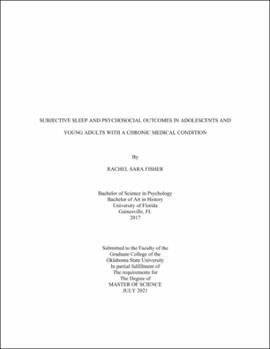| dc.description.abstract | Adolescents and young adults (AYA) with chronic medical conditions (CMCs) appear to be at risk for poorer sleep behavior, such as sleep hygiene and quality. Further research is needed to identify psychosocial mechanisms for the development of sleep difficulties in this population. We aimed to investigate whether sleep quality and hygiene are worse in AYA in the college setting with a CMC as compared to a matched sample physical healthy youth. We also proposed path models for how illness uncertainty, internalizing symptoms, and pre-sleep cognitive-emotional arousal (i.e., worry and rumination at bedtime) predict sleep quality in this population. College students (n = 274) with and without a self-reported CMC (n = 137 in each group) at a Midwestern university reported on anxious and depressive symptoms, sleep quality, and sleep hygiene. Participants with a CMC also reported on illness uncertainty. Path analysis was used to compare the internalizing symptoms --> cognitive-emotional arousal --> sleep quality relationship in participants with and without a CMC. Then, path analysis evaluated the direct and indirect effects of illness uncertainty --> internalizing symptoms --> cognitive-emotional arousal --> sleep quality. AYA with a CMC generally reported poorer sleep behavior than the non-CMC group, including poorer sleep quality and greater cognitive-emotional arousal. The indirect effect of internalizing symptoms on sleep quality via cognitive-emotional arousal was significant in the CMC group, B = -.27, SE = .08, 95% CI [-.410, -.116]; this indirect effect was not significant in the non-CMC group, B = -.12, SE = .07, 95% CI [-.275, .018]. Illness uncertainty demonstrated a significant indirect effect on sleep quality though the consecutive influence of internalizing symptoms and cognitive-emotional arousal, B = -.20, SE = .06, 95% CI [-.341, -.094]. Results suggest that AYA with a CMC in the college setting are at risk for worse subjective sleep behavior than their peers. Findings from this cross-sectional assessment suggest that sleep quality in this population may be predicted by the relationship between internalizing symptoms and cognitive-emotional arousal. Finally, the association between illness uncertainty and sleep quality in AYA with a CMC may be explained by the consecutive influence of internalizing symptoms and cognitive-emotional arousal. | |
